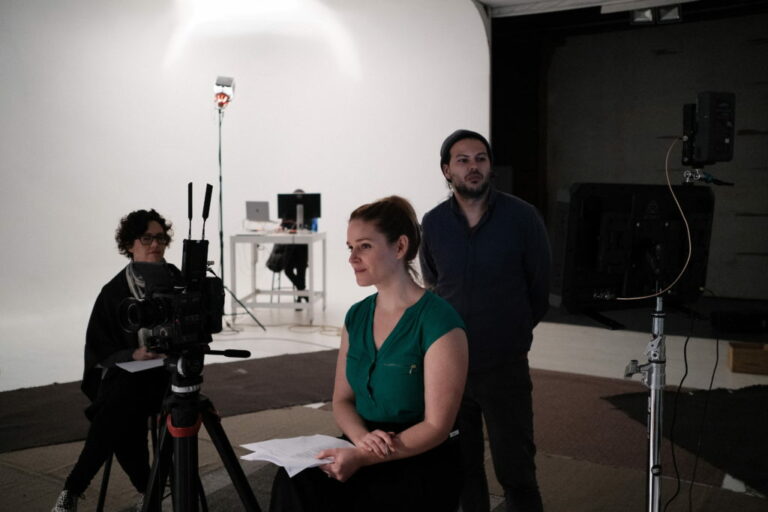
Writing a brief for your live action video can be daunting – especially if you have not written one before. There are plenty of different things to consider, so it’s normal to be unsure of how to start.
Let’s break it down.
I’m Dana, and I’m the Senior Creative Producer and Director here at Creativa. I’ve worked in post-production and production since 2005 – so you’re in good hands!
First off, it’s helpful to know that ‘live action’ means that your video is not animated.
In this post, I’ll ask the important questions to help you understand what to include in your brief.

This is me on the set of our live action shoot for Advance Care Planning
Your answers will help whoever you work with get an overview of your project. If you’re working with a production team, they’ll be able to create a plan of action based on your brief. From big picture distribution, to what genre your video would suit best.
A quick disclaimer. Don’t worry if you don’t immediately know all the answers to these questions. But, no matter how long it takes, it is important you work through them before the cameras start rolling.
Once you have worked through these questions, you’ll have a clear brief for your video. This will help the production company you work with feel more informed and aligned to your goals. This will then help your video achieve the goals you’ve set.
Because why create a video in the first place if it’s not going to do what you need it to do?
- What is a Live Action Video Brief, and Why Does it Matter?
- Let’s Write Your Live Action Video Brief
- A Step by Step Process
- Step 1: Start With Why
- Step 2: Where Will It Live?
- Step 3: Who Is The Video For?
- Step 4: What Do You Want Your Audience To Do?
- Step 5: What Are Your Goals?
- Step 6: Budget & Logistics
- Optional Step: What Is Your Inspiration?
- Congratulations! You Have A Live Action Video Brief.
What is a Live Action Video Brief, and Why Does it Matter?

Every project should start with a brief.
A brief gives an overview of the project, what its goals are, the audience and the deliverables. It also helps you to define a successful video looks like. And by extension of that, how you will measure its success.Your brief becomes the guide for everyone involved, from pre-production to post-production. It’s like a map. And it stands to reason – without a map, you can get lost.
I know this behind-the-scenes work is time consuming. But, your video brief sets you up for success.
Let’s Write Your Live Action Video Brief
A Step by Step Process
I’m going to take you through six steps to create a video brief that is:
- helpful
- informative
- effective
- aligned to your business goals
Let’s set you up for success!
Step 1: Start With Why

As Simon Sinek recommends: start with why.
Why do you need to make a video in the first place?
Here are some questions to ask yourself to get the ball rolling:
- What do we want this video to achieve?
- Who is our audience and what do we want them to do?
- What does success look like?
Some possible reasons you could come up with:
- We want to come across as more personable and human on our website
- We want to use emotion so we can drive our audience to take a certain action
- We an interesting story we want to document for key stakeholders
There’s no wrong answer here.
For example, if you were looking to recruit more employees, your why would reflect that. ‘We want prospective employees to see our healthy company culture’. Great!
Once you’ve brainstormed a couple of reasons, pick the one that stands out to you. This ‘why’ will act as a guiding light for the video brief. It will help you stay on track during the pre-production process. It will also help give you clarity when you are making decisions with your team.
It will influence decisions like:
- what actors you work with in production
- the language and vocabulary in the script
- where you will shoot the video
- what call to action you want to include
Having a clear why means you can make decisions and move forward in the project with confidence.
Over to you:
Write down why you’re wanting to make this video.
Step 2: Where Will It Live?

Step 3: Who Is The Video For?

Who is your target audience for this video? This is an important question.
Write down who this video is for.
Step 4: What Do You Want Your Audience To Do?

Now that you know where it will go and your audience, have a think about what you want them to do after watching the video.
Maybe you have a specific call to action, like asking them to sign up for a new deal. Perhaps it’s to call your business. Maybe it’s that you want your audience to have renewed confidence or positive affinity with your business.
Your intended audience action – also known as the ‘call to action’ – will help you or your production company define the feel of the video.
For example, whether it is a jovial or a somber call to action. A ‘call us now for 50% off’ will need a different treatment to a ‘contact us now to organise your will’.
Over to you:
Write down what action you want your audience to take after watching your video.
If you want to define it even further, include some emotions you want your audience to feel when watching your video.
Step 5: What Are Your Goals?
Let’s imagine that your video went viral. You got millions of views, and tons of people shared it. Yet, your goal was to get 100 new sign ups for your newsletter.
But no one clicked through to your website to sign up.
Was your video successful? Well, even with those millions of views, if no one signed up to your newsletter, I would say your video was a bust. It didn’t meet your goal. So to avoid situations like this, you need to be clear on your goal for the video, and let it guide the entire production process.
Your goal vs your call to action
Steps 4 and 5 are closely linked. You need to know your goal so you can create an appropriate call to action.
But, your goal is different from your call to action. Your call to action is for your audience. Your goal is what you’re going to look to when measuring success at the end of your campaign.
Identifying your goal
It could be marketing related, sales, event-specific, or otherwise.
For example, a marketing goal could be to get 50 sign ups for an online webinar. So, you produce an exciting, punchy 30 second promo video for the online event that you release on your Facebook page. And your video has a clear call to action to sign up via the link in the post. Maybe it has a limited time offer that the first 50 sign ups get 10% their tickets.
This is an example of making sure that your goal influences each aspect of your video.
Your goal = what the purpose of the video is. I recommend that you make it SMART = Specific, Measurable, Achievable, Relevant, Timely.
Identify what metrics you are going to measure
Once you know your goal, identify what the metrics are that you’ll use to measure its success.
This is where it’s helpful to know what action you want your audience to take, as you can use that as measurement.
For example, if your goal is event sign ups, then you could measure the amount of attendees that signed up because of your video. Let your producer know what success looks like and they’ll make sure you have a strong call to action that will help your video reach its goals.
Consider distribution strategy
This is the step where you would consider what your distribution strategy is. Your distribution strategy is how you will get your video in front of your audience – and it goes a bit deeper than just where you’ll release it. If you’re not clear on this yet, make a note of this so you can discuss it with your production team.
Over to you:
Write down what goal (or goals!) this video is supporting for your business, and what metrics you’ll use to measure success.
Step 6: Budget & Logistics
This step is all about logistics and budget – both important to include in a brief so that your producer can know whether you’re working towards any particular dates or costs.
Include Any Dates And/Or Timelines
Does your producer need to know about any dates you’re working towards? These could be a specific date you need the project delivered by, or maybe a general time frame that you need to produce the video in (because of your availability or you’re wanting to film at a certain location etc.).
Let’s Talk Budget
You’re working towards a budget. You know it – we know it – your producer knows it!
So don’t be shy about including it in your brief. Even if you’ve just got a ballpark estimate (e.g. We’re budgeting somewhere in between $15,000 – $35,000), it’s worth putting it on the table so that your producer knows your budget.
To give you an idea of what this could mean – a smaller budget means you will need to sacrifice or make compromises on the final deliverable (we find that clients can often underestimate the cost of live action), so be prepared to negotiate your deliverable. When you’re working with an experienced production company, doing this doesn’t mean you’re going to get a ‘bad’ video – not at all! On my projects, I match the creative (aka your final deliverable) around the budget – rather than trying to recreate the film Titanic with a budget of $2,000.
When you’re not trying to overachieve with limited resources, your creative (and your producer) will thank you.
Over to you:
Note down what dates are important to the timeline of your project, and include a project budget, even if it is a ballpark figure.
Optional Step: What Is Your Inspiration?
This step is optional because I know that not every project comes with clear visual inspiration for the video. You might have some idea of what style/vibe you are looking for, but then again you might just be looking to hand that side of the project to the producer you are working with.
I encourage you to do some thinking on what existing videos you think suit your brand. If you have seen something that you love that you are inspired by, show your producer! A picture speaks for a thousand words and we producers love checking out great content.
Alternatively, you can provide your production company with your brand style guide and they can work with you from there.
Over to you:
Note down some videos that inspire you and suit your brand.
Congratulations! You Have A Live Action Video Brief.
Now that you have the basics of your live action video brief written up, you’re on your way to a successful project and measurable video.
While some of the specifics of the brief may change during the course and execution of the project, the work you have done has set you up for success in the project. From here, you start to work with the production team you have hired for this project. If you don’t have one organised and need some help with that side of things, talk to our team about joining you on your live action video production adventure.







